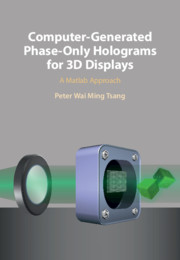
-
Select format
-
- Publisher:
- Cambridge University Press
- Publication date:
- 07 January 2021
- 21 January 2021
- ISBN:
- 9781316999172
- 9781108427333
- Dimensions:
- (244 x 170 mm)
- Weight & Pages:
- 0.54kg, 210 Pages
- Dimensions:
- Weight & Pages:
You may already have access via personal or institutional login
Book description
'Phase-only Fresnel holograms,' which can be displayed on a single SLM without the need for lenses or complicated optical accessories, substantially simplifies 3-D holographic display systems. Exploring essential concepts, theories, and formulations of these phase-only Fresnel holograms, this book provides comprehensive coverage of modern methods for generating such holograms, which pave the way for commercial products such as compact holographic projectors, heads-up displays, and data security enhancement. Relevant MATLAB codes are provided for readers to implement and evaluate the theories and formulations of different methods, and can be used as a quick start framework for further research and development. This is a crucial and up-to-date treatment of phase-only Fresnel holograms for students and researchers in electrical and electronic engineering, computer science/engineering, applied physics, information technology, and multimedia technology, as well as engineers and scientists in industry developing new products on 3-D displays and holographic projection.
Reviews
‘MATLAB programs, scattered throughout the book, might be the starting point for further research and be used as an educational tool (there are exercises at the end of each chapter). References are adequate, useful and up-to-date, while the index improves readability. The book is specialized, and I recommend it to those who actively use SLMs for holographic manipulation of light, but it can be useful to a more general community dealing with digital holography.'
Dejan Pantelić Source: Optics & Photonics News
Contents
Metrics
Full text views
Full text views help Loading metrics...
Loading metrics...
* Views captured on Cambridge Core between #date#. This data will be updated every 24 hours.
Usage data cannot currently be displayed.
Accessibility standard: Unknown
Why this information is here
This section outlines the accessibility features of this content - including support for screen readers, full keyboard navigation and high-contrast display options. This may not be relevant for you.
Accessibility Information
Accessibility compliance for the PDF of this book is currently unknown and may be updated in the future.


